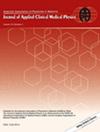The burden of burnout: Understanding its prevalence and organizational drivers in medical physics
Abstract
Background
Burnout is a work-related syndrome characterized by increased levels of emotional exhaustion (EE) and depersonalization (DP) along with decreased levels of personal achievement. In the healthcare setting, higher burnout levels have been associated with negative impacts on personnel, an increased risk of errors, and a decrease in the quality of delivered care.
Purpose
The purpose of this study was to assess the prevalence of burnout among medical physicists working in the United States. Additionally, the impact of personal and organizational features on burnout risk was examined.
Methods
The anonymous survey was distributed to 1962 full members of the American Association of Physicists in Medicine. The survey consisted of seven demographic questions, the validated Maslach Burnout Inventory (MBI), and an organizational assessment tool. Burnout risk was evaluated using two different scoring methods. Inferential statistics were employed to examine the relationship between burnout and personal features, such as practiced sub-specialty, and organizational features, including the respondent's assigned facility safety score.
Results
A total of 337 responses were received, and 59.9% of medical physicist participants scored high on at least one burnout domain. A statistically significant association was found between the EE and DP burnout domains and personal factors, including working as a therapy medical physicist, working longer hours, and a moderate or significant impact on work-related feelings due to the COVID-19 pandemic. A statistically significant relationship was identified between all three burnout domains and the respondent's assigned facility safety score. Amongst therapy physicists, an inverse relationship was observed between all three burnout domains and both the teamwork and staffing constructs, as well as the open communication and punitive concerns construct.
Conclusions
Medical physicists in the United States are experiencing significant levels of burnout. Importantly, this study identified a link between quantitative burnout scores and facility safety, stressing the importance of addressing burnout.

 求助内容:
求助内容: 应助结果提醒方式:
应助结果提醒方式:


